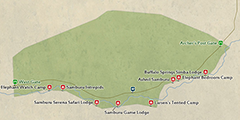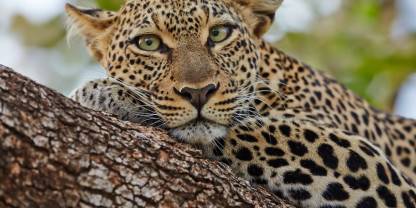If you visit one reserve in Kenya’s north, make it Samburu National Reserve. Filled with wildlife, including many desert-adapted specials, Samburu is also incredibly scenic: the park is relatively compact, framed between austere, barren mountains and the fertile banks of the Ewaso Nyiro River. You’re in the heart of Samburu country here, which provides a fascinating cultural backdrop, too.

-
Best Time To Go
- June to September and January to February
-
High Season
- December to March and July to October (Busy)
-
Size
- 165km² / 64mi²
-
Altitude
-
842-1,064m /2,762-3,491ft
 View Photos
View Photos
 View Photos
+24
Photos
View Photos
+24
Photos
 Open Map
Open Map
Pros & Cons
- Very good wildlife viewing in the Dry season
- Four of the are easily found (no rhino)
- Interesting mammal species that you can see only in the arid north
- Beautiful scenery
- Excellent birding with many dry-country specials
- A good range of accommodations catering to different budgets
- Very hot and dry
Wildlife
Samburu offers great wildlife viewing and four of the are present. Rhinos are absent, but herds of elephant cross the reserve. Of the , leopards are commonly seen, with some high-quality sightings possible. Most interesting are the northern Kenya specials, often called the Samburu Five: , , , and . Samburu is one of few parks where you can see the .
More about Samburu's wildlifeScenery
Samburu is among Kenya’s most scenic reserves, with along the lovely Ewaso Nyiro River. Close to the river is also where you’re most likely to see leopards. Near the river, dry scrub and semi-arid , peppered with termite mounds, takes over and extends all the way to the mountains that define the park’s northern boundary. Koitogor Hill marks the middle of the reserve.
Activities
The main activities in Samburu are guided , where you’ll be driven around in a 4WD safari vehicle or minibus to look for animals and birds. It may also be possible to leave the park to visit a local Samburu village community in the company of a local guide.
Weather & Climate
Hot is the best way to describe Samburu, although the average temperature more than halves at night. Rug up if you’re heading out on an early morning game drive. The Dry season (June to September) lives up to its name, with almost no rain. Similarly, in good years, the Wet season (October to May) turns the country a lovely shade of green.
More about the weather and climateBest Time To Visit
Dust hangs in the air in the Dry season (June to September), giving the landscape a hazy look. But it’s still the best time to check out the local wildlife due to decent road conditions and little vegetation to obscure your view. The hot, dry months of January and February are also good for seeing wildlife. Birdlife is at its most vibrant and spectacular in the wetter months (November to April).
More about the best time to visit



